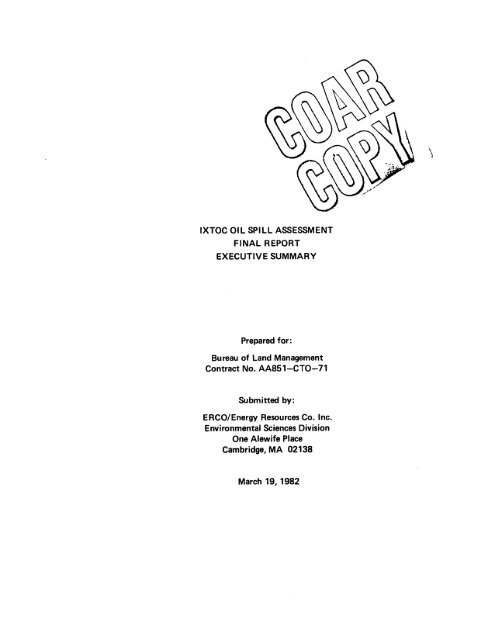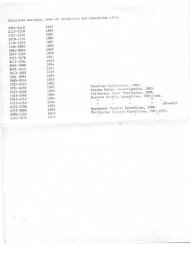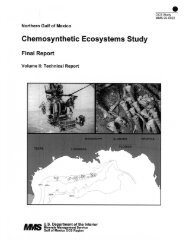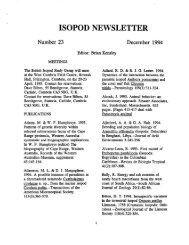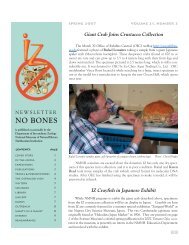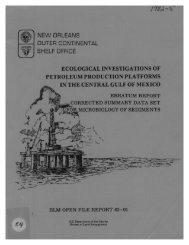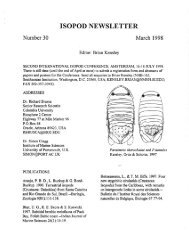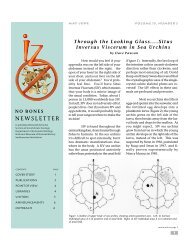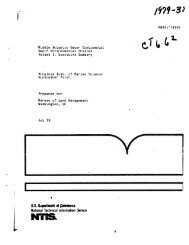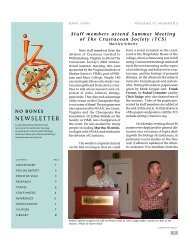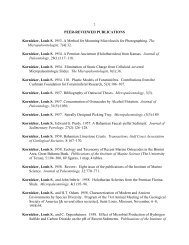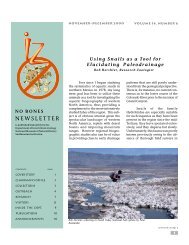ixtoc oil spill assessment final report executive summary
ixtoc oil spill assessment final report executive summary
ixtoc oil spill assessment final report executive summary
You also want an ePaper? Increase the reach of your titles
YUMPU automatically turns print PDFs into web optimized ePapers that Google loves.
IXTOC OIL SPILL ASSESSMENT<br />
FINAL REPORT<br />
EXECUTIVE SUMMARY<br />
Prepared for :<br />
Bureau of Land Management<br />
Contract No. AA851-CTO-71<br />
Submitted by :<br />
ERCO/Energy Resources Co . Inc .<br />
Environmental Sciences Division<br />
One Alewife Place<br />
Cambridge, MA 02138<br />
March 19, 1982
EXECUTIVE SUMMARY<br />
1 .<br />
2 .<br />
3 .<br />
4 .<br />
5 .<br />
6 .<br />
7 .<br />
INTRODUCTION<br />
SAMPLING<br />
CHEMICAL ASSESSMENT<br />
BIOLOGICAL ASSESSMENT<br />
TABLE OF CONTENTS<br />
EVALUATION OF DAMAGE ASSESSMENT PROGRAM<br />
REFERENCES<br />
INDEX<br />
Page<br />
1<br />
9<br />
12<br />
22<br />
27<br />
33<br />
35
1 . Introduction<br />
EXECUTIVE SUMMARY<br />
Pollutant inputs to the marine environment fall into two general<br />
classes : continuous or chronic introduction and acute or episodic additions .<br />
The chronic addition of certain products of industrial development, including<br />
petroleum-related material to coastal marine systems, has had profound impact<br />
on indigenous marine populations and has altered the use of some localized<br />
marine environments for significant periods of time (e .g ., New York Bight, as<br />
a result of ocean dumping) . Other chronic inputs such as those that result<br />
in input of tar/<strong>oil</strong> to the Texas Gulf Coast (Geyer ;, 1981) have less of an<br />
obvious ecological impact, if any . The Brittany coast of France has been<br />
affected for several years by the acute <strong>oil</strong> input from the Amoco Cadiz tanker<br />
<strong>spill</strong> (CNEXO, 1981), as has the Tierra del Fuego region as a result of<br />
the Metula <strong>spill</strong> (Straughan, 1978) . The existence of substantial baseline<br />
information allowed both obvious and subtle impacts of <strong>oil</strong> <strong>spill</strong>s to be<br />
detected in the cases of the West Falmouth <strong>oil</strong> <strong>spill</strong> (e .g ., Burns and Teal,<br />
1980) and the Tsesis <strong>oil</strong> <strong>spill</strong> (Linden et al ., 1979) . An integral part of<br />
the impact <strong>assessment</strong> process is monitoring the return to pre-<strong>spill</strong> conditions<br />
as was undertaken for the Zoe Colocotroni (Gilfillan et al ., 1981) and<br />
Amoco Cadiz (NOAA, 1982) <strong>spill</strong>s .<br />
Offshore exploration and production of petroleum deposits on the Continental<br />
shelf was and is a logical extension of land and nearshore production<br />
of <strong>oil</strong> . The goals of the U .S . Department of the Interior, Bureau of Land<br />
Management's Outer Continental Shelf (OCS) Environmental Study Program are<br />
to : (1) obtain environmental data on the impacts of petroleum exploration<br />
and production activities on the OCS, and (2) provide relevant information<br />
for the decision making (management) process vis-a-vis offshore minerals<br />
management .<br />
The blowout of the Ixtoc I offshore drilling rig in the Bay of Campeche,<br />
Mexico on June 3, 1979, resulted in the release of half a million metric tons<br />
(140 million gallons) of <strong>oil</strong> into the Gulf of Mexico (OSIR, 1980) and transport<br />
of a significant part of this <strong>oil</strong> northward into U .S . coastal waters<br />
(Figure 1-1) . Surface <strong>oil</strong> entered U .S . waters on August 6, 1979 (OSIR, 1980)<br />
and continued to be seen in significant surface concentrations (i .e . patches<br />
of <strong>oil</strong>, sheen) until the northward-flowing western Gulf of Mexico current<br />
reversed direction during September 1979 . The wel :l was <strong>final</strong>ly capped on<br />
March 23, 1980 . During this period of time approx :imately 4-11 thousand<br />
metric tons (1-3 million gallons) of Ixtoc <strong>oil</strong> impacted the beaches and<br />
resided offshore in tar mats (OSIR, 1980 ; Gundlach et al ., 1981) . Perhaps 5<br />
to 10 times as much <strong>oil</strong> passed through the Texas OCS region, largely in the<br />
form of small patches of emulsified <strong>oil</strong> (mousse) (Patton et al ., 1981),<br />
without affecting the shoreline . Approximately 180 tons of <strong>oil</strong>, or less than<br />
5 percent of the total quantity of <strong>oil</strong> initially beached (til million gallons),<br />
was present in the tar mats . The beached <strong>oil</strong> was removed naturally and<br />
either redeposited in the nearshore bar/trough system or taken further<br />
offshore . The ultimate fate of the bulk of the <strong>oil</strong> remains unresolved,<br />
-1-
280<br />
260<br />
BURMAH AGATE STUDY<br />
PRIMARY STUDY AREA (STOCS)<br />
SECONDARY STUDY AREA<br />
240 Wesnrn Gulf of M.xiao<br />
220<br />
200<br />
Caba Rojo<br />
Vera Cruz<br />
SECONDARY STUDY AREA<br />
0 120<br />
~<br />
J<br />
NAUTICAL MILES<br />
IXTOC I BLOWOUT SITE<br />
a<br />
990 980 940 920 900<br />
Figure 1-1 . Overall Location of Study Areas .<br />
-2-<br />
Mississippi'<br />
DNta<br />
Yucatan P.ninsula i
although the weathering and physical breakup process, described by Patton<br />
et al . (1981) and Boehm et al . (1981), followed by distribution of small<br />
tarry particles in surface and subsurface waters in the Gulf of Mexico waters<br />
seems likely .<br />
Early in November 1979 and still during the Ixtoc I <strong>spill</strong>, the tanker<br />
Burmah Agate collided with the freighter Mimosa approximately 5 miles off<br />
Galveston, Texas (Figure 1-2) . The collision resulted in the release of<br />
probably several million gallons of crude <strong>oil</strong> into offshore waters . Kana and<br />
Thebeau (1980) have estimated that approximately 21 thousand metric tons<br />
(150,000 barrels) burned in the ensuing fire . They also estimated that<br />
7,000 metric tons (48,000 barrels) dispersed offshore during northerly winds .<br />
Approximately 10% of this <strong>oil</strong> was recovered offshore, leaving a large portion<br />
of the <strong>spill</strong>ed <strong>oil</strong> to weather by evaporation, phot.ochemical oxidation, etc .,<br />
or to become mixed in the water column . The fate of the remaining <strong>oil</strong><br />
includes (1) emulsification and dispersion, (2) mixing with sediment followed<br />
by sinking to the benthos, or (3) direct sinking of partly combusted residual<br />
<strong>oil</strong> from the fire . Crude <strong>oil</strong> exposed to high temperatures, such as those<br />
produced during the fire, shows a rapid loss of volatile low-molecular-weight<br />
material causing an increase in density followed by rapid sinking in seawater<br />
(Kolpack et al ., 1978) . Sinking of large amounts of partly combusted <strong>oil</strong> and<br />
ash was the major fate of <strong>oil</strong> <strong>spill</strong>ed and burned during the Sansinena <strong>oil</strong><br />
<strong>spill</strong> in Los Angeles Harbor (Kolpack et al ., 1978), a similar <strong>spill</strong>/fire<br />
event .<br />
The <strong>spill</strong>ed <strong>oil</strong> from the Burmah Agate was observed to have an impact on<br />
the Texas coast considerable distances from the wreck ( -,270 km) .<br />
A study of the impact of these <strong>spill</strong>s on the marine environment should<br />
focus on an environmental compartment (e .g ., offshore benthos) likely to be<br />
affected over a long enough time period to enable an accurate damage <strong>assessment</strong><br />
. In the case of the Ixtoc / Burmah Agate <strong>spill</strong>s the circumstances for an<br />
accurate damage <strong>assessment</strong> were favorable because a baseline study of the<br />
South Texas Outer Continental Shelf (STOCS) area had been conducted from<br />
1975 to 1977 . This baseline information, generated as part of the BLM<br />
Environmental Study Program's STOCS program (conducted from 1975-1977),<br />
consists of a variety of biological, geological, biogeochemical, and chemical<br />
oceanographic data describing the pre-<strong>spill</strong> state of the OCS region .<br />
Given the Ixtoc <strong>spill</strong>'s history, the beaching and apparent offshore<br />
transport of petroleum, and the existence of significant amounts of suspended<br />
matter in the water column of the STOCS region, one would expect that<br />
detectable sedimentary petroleum residues would be revealed .<br />
In this light, the BLM contracted ERCO and its subcontractors, LGL<br />
Ecological Research Associates, Global Geochemistry Corporation, and Geomet<br />
Technologies, to undertake a detailed <strong>assessment</strong> of the impact of the Ixtoc<br />
<strong>spill</strong> and the Burmah Agate "complications" on the offshore benthos of the<br />
STOCS region .<br />
-3-
1<br />
r 1<br />
~ BURMAH AGATE LA .<br />
ONSHORE IMPACTS<br />
NOVEMBER 1979<br />
TEXAS<br />
.s TONS<br />
• O<br />
M AP AREA<br />
HOUSTON<br />
~<br />
~ GALVESTON ISLAND<br />
~ ~ 70 TONS .<br />
~<br />
150-200 TONS<br />
MATAOORDA PENINSULA<br />
~ ~ 3Al1i'jOSE ISLAND N<br />
CORPUS CHRISTI a~ ~<br />
pAOf7E ISLAND<br />
Primary VF<br />
Study Area ~<br />
50 0 _ 50<br />
* .-~-1.0 TON(10 NOV) ~J<br />
. KILOMETERS<br />
~, °>?BAit'ZOS ISLAND 50 0 50<br />
MIIES<br />
Figure 1-2 . Location Map of Burmah Ag a te Onshore Impacts in Nov . 1979<br />
(from Kana & Thebeau, 1980) .
The primary objectives of the Ixtoc <strong>assessment</strong> study are to examine and<br />
quantify the chemical impact of the Ixtoc and Burmah Agate <strong>spill</strong>s on the<br />
offshore benthic environment and to determine if such impacts resulted in<br />
sustained perturbation of the benthic biological com ayi nity. Thus, while the<br />
study relies heavily on information contained in samples from the Texas<br />
beaches and from the wellhead region, the <strong>assessment</strong> study focuses on the<br />
offshore Texas OCS (Figure 1-3) from an area seaward of the offshore bars<br />
(^..3 metres depth) to the 60-metre depth contour some 30-40 miles offshore .<br />
A second objective was to determine to what extent and for what duration<br />
an important commercial fisheries resource, the shrimp fishery, had been<br />
chemically affected as a result of these specific <strong>spill</strong>s .<br />
The integrated damage <strong>assessment</strong> strategy for this project involved<br />
the following elements :<br />
1 . Determination of what habitats have been affected .<br />
2. Determination of the nature and extent of the chemical impact .<br />
3. Determination of whether biological and ecological perturbations<br />
resulted from this impact as compared to both the pre-<strong>spill</strong><br />
environment (baseline information) and the unaffected environment<br />
(reference stations) .<br />
4 . Determination of a causal relationship,between any observed<br />
biological changes and the chemical impact .<br />
5 . Determination of damage to a commercially important resource<br />
(shrimp fishery) due to the chemical impact .<br />
6 . Determination of the pre-<strong>spill</strong> value of the ecological and/or<br />
commercial resource and the extent to which its use and/or value<br />
has been diminished .<br />
Elements 1 and 2 are chemical questions whose answers define the exposure<br />
of an ecological system to contaminants from a particular <strong>spill</strong> . A<br />
detailed chemical-source fingerprinting has to be combined with a knowledge<br />
of possible weathering sequences to identify locations within habitats<br />
specifically affected by a <strong>spill</strong> event . Element 3 involves a detailed<br />
analysis of the biota, its abundance and diversity, and a comparison of<br />
pre-<strong>spill</strong> measurements with a knowledge of the range of natural variability .<br />
Element 3 then draws on the results of 1 and 2 to address element 4 . Impacts<br />
on commercial species, which affect marketability and human health, are<br />
separately defined through chemical analyses of tissues specifically directed<br />
to quantification of toxic aromatic hydrocarbons . The assignment of pre<strong>spill</strong><br />
"value" is beyond the scope of this project, but the overall goal of<br />
assigning an "extent of damage" in a quantifiable form from the biological<br />
data is central to the damage <strong>assessment</strong> strategy .<br />
-5-
280<br />
27°<br />
2E°<br />
t :. :<br />
.~~<br />
. . T~+y'NN•"<br />
STUOY MIfA<br />
: ~4t<br />
OOtt h<br />
013<br />
32 16<br />
.<br />
19<br />
3ULf Of ao O<br />
MlX~q A/twCO : :, ~'O 21 20<br />
zs<br />
:' Sr
As no comprehensive offshore damage <strong>assessment</strong> of this nature has<br />
previously been undertaken, we feel that the best way to accomplish the<br />
program objectives is to address specifically the impacts of the <strong>spill</strong>s<br />
under consideration and to establish and test our methods under the<br />
broader context of "damage <strong>assessment</strong> methodology development ." Therefore<br />
in many cases, new techniques and their applications have been used singly or<br />
in combination to address the program objectives . These have been explored<br />
in more detail in the technical chapters .<br />
The basic elements of the project strategy were to :<br />
1 . Obtain a set of biological, chemical, and support data from<br />
samples obtained during Regional Response Team activities, August-<br />
December 1979 (i .e ., mid-<strong>spill</strong>) .<br />
2 . Obtain a set of biological, chemical, and support data from<br />
samples obtained during the December 1980 . Tonya and Joe cruise<br />
(i .e ., post-<strong>spill</strong>) .<br />
3 . Compare mid- and post-<strong>spill</strong> biological and chemical "conditions"<br />
with each other and with pre-<strong>spill</strong> "conditions" (BLM-STOCS program) .<br />
4 . Examine possible cause-and-effect relationships by synthesizing<br />
biological and chemical measurements .<br />
5 . Define magnitude and areal extent of Ixtoc <strong>spill</strong>-related damage .<br />
In order to achieve the program's basic objectives as previously outlined,<br />
two sets of environmental samples, one from the mid-<strong>spill</strong> time period<br />
(mid to late 1979) and one from the post-<strong>spill</strong> time period (late 1980),<br />
were obtained . From these samples biological and chemical information was<br />
extracted by a variety of methods and compared to the substantial pre-<strong>spill</strong><br />
(1975-1977) data on similar samples . This latter set, from the STOCS/BLMsponsored<br />
benchmark program, provided a base with which to compare the<br />
pre-, mid-, and post-<strong>spill</strong> biological and chemical data . The value of the<br />
<strong>spill</strong> <strong>assessment</strong> program depends upon its ability to detect environmental<br />
changes and to assign them to proper causes . The STOCS program included a<br />
variety of environmental measurements made over a 3-year period (1975-1977)<br />
and therefore represents a potentially valuable source of information,<br />
especially with regard to temporal variations in biological and chemical<br />
parameters .<br />
All program elements operated independently, as indicated in Figure 1-4,<br />
until causal relationships were explored during the data synthesis effort .<br />
A variety of samples were collected for the chemical analysis program .<br />
Three basic sets of samples were collected :<br />
-7-
CHEMISTRY<br />
Establish Fingerprints<br />
of Possible Range of<br />
Oil Compositions<br />
Screen Samples for<br />
Petroleum Presence<br />
Quantify Levels of<br />
Petroleum Pollutants<br />
& Identify Source<br />
Compare with<br />
Pre-Spill Data<br />
Supportive<br />
Geochemical Data<br />
Establish Causal<br />
Relationship<br />
Quantify Extent of<br />
Oil Induced Change<br />
Figure 1-4. Overall Technical Approach & Flow of Information .<br />
-8-<br />
BIOLOGY PROGR AM<br />
Define Benthic Biology<br />
Community Structures<br />
Compare with<br />
Pre-Spill Data
1 . Samples designed to aid in establishing the possible range of<br />
"chemical signatures" of weathered Ixtoc and Burmah Agate <strong>oil</strong>s .<br />
a. Floating <strong>oil</strong>/tars .<br />
b . Beached <strong>oil</strong>/tars .<br />
2 . Samples designed to establish the presence of <strong>oil</strong> in the offshore<br />
benthic environment .<br />
a . Surface sediments .<br />
b . Sorbent pad samples (water-column-borne <strong>oil</strong>/resuspended<br />
sediment) .<br />
3 . Samples designed to establish <strong>spill</strong> impact on epifaunal populations .<br />
a. Penaeid shrimp .<br />
The biology program relied on collections of benthic infaunal organisms<br />
from sediment grab samples .<br />
The geochemical support program included determinations of sediment<br />
texture or grain - size distributions for all benthic biological samples and<br />
sedimentary total organic carbon (TOC) on benthic biological and chemical<br />
samples .<br />
Four organizations participated in the study and their roles are indicated<br />
in Figure 1-5 .<br />
2 . Sampling<br />
Three sets of samples and/or data collected from the South Texas Outer<br />
Continental Shelf were potentially available for the Ixtoc I <strong>oil</strong> <strong>spill</strong><br />
<strong>assessment</strong> . These sets were BLM-STOCS (1974-1977), Regional Response Team<br />
(1979), and BLM-ERCO (1980) . The BLM-STOCS Benchmark Study obtained baseline<br />
concentrations of petroleum in sediments and samples collected from 1974 to<br />
1977 . These samples were collected from 12 primary stations (Figure 1-3) .<br />
Data from this program were available on a set of NODC data tapes .<br />
The RRT and other groups, such as the NOAA Researcher/Pierce team,<br />
collected samples from July to December 1979 during the blowout event .<br />
Sediment, shrimp, and sorbent pad samples were collected from sites that<br />
included the 12 primary stations and other secondary stations (Figures 1-3,<br />
and 2-1) . Additional shrimp samples were collected by the National Marine<br />
Fisheries Service at dockside from shrimp fishermen fishing in the study<br />
region . The sampling location was determined post facto by interviewing<br />
the shrimpers and is without a doubt less certain than for the other samples .<br />
Beached <strong>oil</strong> samples were collected by a variety of individuals from a variety<br />
of stations .<br />
-9-
ERCO<br />
- Hydrocarbon Chemistry (UV, GC, GC/MS)<br />
-Sam pl ing<br />
-Data Management<br />
-Del iverables<br />
-Project Management<br />
LGL Associates I I Global Chemistry<br />
I I Geomet Technologies<br />
-iment<br />
-Benthic Biology -Isotope Chemistry ~<br />
-Sampling -TOC Analysis Texture-Grain Size<br />
Analysis<br />
Figure 1-5 . Organizational Overview Showing Major Responsibilities of<br />
Each Participating Group .<br />
-10-
290<br />
280 ~<br />
270 ~<br />
2 60<br />
250<br />
240<br />
1<br />
•AN E<br />
~ •AN0<br />
~ ~ •AN C<br />
~.:. ..: ' `<br />
rR30 PRIMARY STUDY AREA (ST0CS)<br />
. R23<br />
R21<br />
1<br />
rf<br />
R24 ~ R26 Rf27<br />
::~~ • ••<br />
• R25 R28<br />
R %-e<br />
• 'R1 R17<br />
R18 ~6 •R16<br />
SAN A<br />
0<br />
~ 0 60<br />
NAUTICAL MILES<br />
SAN 8<br />
ggo 970 g8o 98Q 940<br />
Figure 2-1 . Antelo pe and Reseracher/Pierce Cruise Sample<br />
Station Locator Map .<br />
-11-
A third set of samples was collected by ERCO and LGL in December 1980 as<br />
part of this BLM study . Sediment and shrimp samples were collected from the<br />
12 STOCS stations, 26 RRT stations, and 6 Burmah Agate stations (Figure 2-2) .<br />
3 . Chemical Assessment<br />
Introduction<br />
In the chemical segment of the damage <strong>assessment</strong> study there are seven<br />
consecutive questions that must be addressed : (1) What is the range of<br />
chemical compositions of the pollution (<strong>oil</strong>) that one can expect to affect<br />
the ecosystem being studied? (2) What are the best chemical parameters to<br />
use to relate presence of <strong>oil</strong> in samples to a source? (3) Is there evidence<br />
of petroleum hydrocarbons (PHC) in environmental samples? (4) What are the<br />
source(s) of these compounds? (5) What are the levels of PHC in the samples?<br />
(6) What is the areal extent of contamination? and (7) Does the extent of<br />
chemical impact change with time?'<br />
It is well known that highly weathered petroleum can begin to lose its<br />
easily identifiable characteristics . The paraffinic fraction can be altered<br />
by oxidation and isomerization, which is followed by alteration of the<br />
aromatic fraction . Highly weathered <strong>oil</strong> requires detailed study by sophisticated<br />
analytical procedures such as gas chromatographic mass spectrometry<br />
to gain successful molecular characterization .<br />
By contrast, examining weathered <strong>oil</strong> at the atomic level through the<br />
isotopic composition of carbon, sulfur, and hydrogen has been suggested as a<br />
technique that succeeds due to the invariant atomic (isotope) signature of<br />
petroleum residues . This multiparameter approach was first used by Sweeney<br />
and Kaplan (1978) for the characterization of California beach tars using<br />
sulfur, carbon, and nitrogen isotopes . The approach was extended to include<br />
hydrogen-deuterium isotopes in a study concluded by Sweeney et al . (1980)<br />
on mousse and tar from the Ixtoc I <strong>oil</strong> <strong>spill</strong> . These studies demonstrated<br />
that stable isotope measurements could successfully differentiate tars from<br />
various sources .<br />
The uptake and retention of <strong>oil</strong> by benthic crustacea, for example<br />
shrimp, is a complex function of the nature of the <strong>oil</strong> in the substrate,<br />
the level of exposure, the organism's behavior and its ability to metabolize<br />
petroleum hydrocarbons . We cannot a priori expect to find whole Ixtoc I <strong>oil</strong><br />
within these organisms unless they were contaminated during capture or have<br />
encountered large concentrations of undegraded <strong>oil</strong> . The analytical focus of<br />
a damage <strong>assessment</strong> program, therefore, should be on both the absolute levels<br />
of total hydrocarbons and the presence of petroleum-derived aromatic hydrocarbons<br />
in tissues, the latter of which may be the most sensitive and relevant<br />
measurements of recent petroleum uptake . Giam et al . (1980) did not detect<br />
aromatic hydrocarbons in STOCS shrimp samples, so any significant hydrocarbons<br />
detected during the damage <strong>assessment</strong> study could relate to Ixtoc or Burmah<br />
Agate <strong>oil</strong> .<br />
-12-
I<br />
F-~<br />
W i<br />
78°7Q'<br />
20010'<br />
.<br />
, . '<br />
w . . .y . ;: .'<br />
..~ . .w. ewaw 944w10' N°40 Y4°JO' W°10' M°1lY<br />
. . .<br />
~ t<br />
.<br />
GALVESION BAY<br />
, . . ~ '<br />
n<br />
~..~ : RI<br />
~ R2CP SITE OF BURMAN AGATE SPILL<br />
~ .<br />
I' .<br />
~ G3<br />
~ Ge<br />
O G6<br />
O G4<br />
GULF OF MExICO<br />
Figure 2-2 . Burmah Agate Sampling Stations .<br />
A<br />
N<br />
o FuN StNton<br />
pcx+b S.mo. allr
Methods and Approaches<br />
The proper utilization and blending of different analytical techniques<br />
is the key to successful chemical <strong>assessment</strong> programs . The analytical techniques<br />
used in this program were (1) ultraviolet fluorescence spectroscopy<br />
(UV/F), (2) high resolution (fused silica glass) capillary gas chromatography<br />
(FSCGC) with flame ionization detection (FID) and sulfur-specific (Hall<br />
Electrolytic Conductivity) detection, (3) computer-assisted gas chromatographic<br />
mass spectrometry (GC/MS), and (4) stable isotope mass spectrometry .<br />
A hierarchical analytical scheme beginning by screening large numbers<br />
of samples for the possible presence of <strong>oil</strong> using a "molecular property"<br />
measurement such as UV/F, and building in analytical complexity as needed,<br />
was developed for examining the molecular and atomic properties of hydrocarbons<br />
in the samples (Figure 3-1) . As applied to the various sample types the<br />
detailed hierarchy shown in Figure 3-2 was utilized .<br />
Conclusions<br />
The following conclusions outline the major findings of the chemical<br />
<strong>assessment</strong> segment of this study .<br />
1 . The use of the combined techniques of capillary GC, capillary GC/MS<br />
and isotope mass spectrometry (isotope MS) to obtain detailed molecular (GC<br />
and GC/MS) and atomic (isotope MS) information on the n-alkane composition,<br />
aromatic hydrocarbon (two to five rings) composition, and stable isotope<br />
(C,H,S) ratios of suspect <strong>oil</strong>s and tars, enabled definitive Ixtoc /Burmah<br />
Agate match-no match conclusions to be drawn . This combined use was equally<br />
effective in eliminating false-positive and false negative results from any<br />
one of the three techniques .<br />
2 . With the availability of several weathered Ixtoc reference <strong>oil</strong>s/tars<br />
n-alkane compositional plots (Figure 3-3) were effective in source matching<br />
during the <strong>spill</strong> period (1979) . As microbial degradation took place and the<br />
n-alkane fingerprint was lost, the use of GS/MS information (ratios of<br />
alkylated phenanthrenes to alkylated dibenzothiophenes), in conjunction with<br />
stable isotope measurements, was most effective in tracking Ixtoc and Burmah<br />
Agate <strong>oil</strong>s .<br />
3 . Carbon isotope measurements on saturate and aromatic fractions<br />
(Figure 3-4) were not alone sufficient to accomplish source-matching .<br />
Significant differences in the hydrogen isotope measurements of Ixtoc and<br />
Burmah Agate <strong>oil</strong>s differentiated the two . Some false Ixtoc-positive determinations<br />
based on 613C and 62H were revealed by 634S determinations on<br />
asphaltene residues (Figure 3-5) .<br />
4 . An examination of surface sediment samples from the mid-<strong>spill</strong> (1979)<br />
and post-<strong>spill</strong> (1980) sample sets by a hierarchical analytical scheme involving<br />
ultraviolet fluorescence spectrometry, fused silica capillary gas chromatography,<br />
and computer-assisted gas chromatographic mass spectometry was successful in<br />
-14-
Sample<br />
Extraction<br />
Sample Cleenup *---4 Sample Extract<br />
UV/Fluoresana<br />
Precipitation of Asphaltbnes<br />
Silicic Acid<br />
Column Chromatoqraplsy<br />
_ ... r __ .<br />
Fraction 1 Fraction 2<br />
~ Saturates Arometia<br />
FSCGC<br />
~ \<br />
. `<br />
-Oil? Yes or No<br />
-Approximate Quantities<br />
Stable Isotopes<br />
lC. H, Sl<br />
-Identity of Weathered Oil<br />
stet :ix : ;itt :tss#<br />
-Detailed Resolution of<br />
GC/MS Comp/ex Mixtures<br />
-Quantities for Major<br />
= Components<br />
-Source Identification ;<br />
Fingerprinting<br />
-Oetailed Compositional Information<br />
-Quantities of Individual Minor PAH,<br />
Hopanes, Azaarenes<br />
-Maximum Chemical Information<br />
Figure 3-1 . Schematic of Analytical Strategy .<br />
-15-<br />
I<br />
li?
I<br />
~<br />
rn<br />
i<br />
GCIMS<br />
I I a I<br />
Lwels of Hydrocsrbom and Source(s) Source Identifieations (F/nysrprints)<br />
/ Biolooy Proyram I<br />
Figure 3-2 . Chemistry Program & Strategy .
I<br />
r<br />
v I
• 2, ~<br />
31<br />
; ,<br />
i<br />
~ .<br />
\ ~ .'<br />
\~ • 3• UNKNOWN<br />
2 ~<br />
.a 1<br />
I f<br />
~ 30 ~<br />
•27<br />
-27 ~~ ts .~1 ~23 ~~•~ IXTOC<br />
Q f 1!• 2120 -~ ~•<br />
U 1` 20<br />
~ i 17 ~<br />
/i ta . . 0 n ~<br />
813C sat .<br />
i et • 1o ~ f<br />
( ~11 ts /<br />
II /<br />
\ t 3 012<br />
1<br />
22<br />
-ZT -Z8<br />
~UfJIM4i<br />
4GATi<br />
Figure 3-4. 'Crossplot of the b13C for the Saturate and Aromatic Fraction for the<br />
Tars and Oils (• 1979 Samples, • 1980 Samples) .<br />
-18-
-Qe<br />
: .<br />
~ • 31<br />
u a,<br />
. •<br />
• ----~ .<br />
~ .~' . ~ . , ~- -~--~`<br />
• ~ ~, » 1 s \<br />
m ~ ao••~• ~ s ~~•aa<br />
BURMAH \<br />
AGATE \<br />
~ 20 ,<br />
• i , ;<br />
c~<br />
`~ IXTOC~~~~~/ ~. u<br />
: ~ ~<br />
, .<br />
~ ~ •'a •,: i<br />
. ~<br />
.<br />
-S B • /<br />
.•<br />
. /<br />
. i<br />
-H S<br />
-g -B -4<br />
u<br />
- p +a +6 +1<br />
6 34S CDT .sP-<br />
Figure 3-5 . Crossplot of the Carbon Isotopes of the Aromatic Fraction Versus the<br />
d34S of the Asphaltenes from Tars and Samples ( • 1979 Samples and • Designates<br />
1980 Samples) .<br />
-19-
examining the sediment hydrocarbon assemblage and showed that no recent<br />
petroleum (>10 ng-g 1) additions from the Ixtoc I or Burmah Agate <strong>spill</strong>s<br />
were present in the primary study area . Burmah Agate <strong>spill</strong> residues were<br />
detected at stations within 20-30 km of the Burmah Agate wreck site .<br />
5 . Sediments do contain widespread evidence of geochemically distributed<br />
(i .e ., covarying with increasing total organic carbon content and<br />
decreasing grain size) chronic pollution dominated by chronic weathered<br />
anthropogenic saturated hydrocarbon residues, low levels of n-alkanes<br />
mostly of biogenic origin, and polynuclear (three to five rings) aromatic<br />
hydrocarbon residues (1-100 ng-g-1 of individual components) . Thus the<br />
South Texas OCS sediments are not pristine in terms of anthropogenic (nonpetroleum-related)<br />
inputs (Figure 3-6) .<br />
6 . Where comparisons with STOCS baseline data were possible, alkane<br />
data as well as hydrocarbon-to-TOC regressions indicated agreement within the<br />
range of temporal variability as determined by the STOCS program . Very few<br />
aromatic hydrocarbon comparisons were possible due to lack of PAH data from<br />
the STOCS program .<br />
7 . The mid-<strong>spill</strong> (1979) and post-<strong>spill</strong> (1980) sediment hydrocarbon sets<br />
indicate that all saturated and aromatic hydrocarbon variations at the 12<br />
primary stations fall within the expected temporal variability as determined<br />
by STOCS data . Mid- to post-<strong>spill</strong> PAH comparisons, although indicating some<br />
variability due probably to sampling variability and patchiness, generally<br />
reveal little temporal change . This is especially true when one considers<br />
the consistancy of the PAH/TOC ratios the 1979 and 1980 data sets .<br />
8 . Regressions of both gross chemical parameters (e .g ., total hydrocarbons)<br />
and individual groupings (e .g ., n-alkanes) or compounds (e .g ., individual<br />
aromatic compounds) with total organic carbon levels (e .g ., Figure<br />
3-7) define the STOCS geochemical environment . Changes in levels of these<br />
compounds or groupings brought on by pollutant inputs (e .g . <strong>oil</strong>) will be most<br />
readily observed as deviations from the geochemical regression . Small incremental<br />
additions of PAH (for example, ti 80 ng/g in Figure 3-6) fall outside<br />
the 95 percent confidence level for this regression and could be considered<br />
to indicate a significant additional pollutant input . Incremental additions<br />
of n,10 ppm of <strong>oil</strong> to sediment would be identifiable as "new" non-normal<br />
additions based on the gross PIiC/TOC regressions . This level of <strong>oil</strong> could of<br />
course be detected easily by both FSCGC and GC/MS analyses .<br />
9 . Ixtoc <strong>oil</strong> was present in the sorbent pad samples, apparently<br />
tied up in the suspended sediment material also captured in these samples .<br />
This significant finding indicates that there was Ixtoc <strong>oil</strong> in the "system,"<br />
associated with mobile sedimentary material (nepheloid layers, or surface<br />
flocculent layer) . An association of surface sediment with this suspended<br />
-2 0-
I<br />
N<br />
FJ ,<br />
TEXAS<br />
1979<br />
r<br />
/~<br />
SO-4<br />
100<br />
~.'/ -<br />
1,~ ~ _ .<br />
; N ~<br />
C ,D 70 ~0<br />
STATUTE MILES'~ ' \<br />
100 • DEPTH IN METERS<br />
111- l y°u<br />
Figure 3-6 . Benzofluoranthene / Benzo (a)Pyrene / Benzo(e)Pyrene Concentrations in Sediments (ng/g) .<br />
2<br />
TEXAS<br />
I,<br />
I -- ~) .. 1<br />
O7o<br />
47<br />
rf/_<br />
.<br />
, N<br />
,G G U 70<br />
, 30<br />
, STATUTE MILES ~ ~ \<br />
/100 • DE P TH IN METERS
material is not definitely established nor is the presence of this suspended<br />
matter definitely linked to biological impact . However, this finding in this<br />
and other studies does point to the inadequacy of the sampling technique<br />
(Smith-Maclntyre grab) in <strong>spill</strong> studies .<br />
10 . Low-level petroleum accumulations noted in GC/MS-derived aromatic<br />
hydrocarbon searches, were a fairly common occurrence in the penaeid shrimp<br />
population . The STOCS shrimp contain petroleum aromatic hydrocarbon levels<br />
in the 10- to 50-ppb range . The implications of these low levels of PAH<br />
compounds on shrimp health or harvestability are uncertain . Higher values<br />
were observed in shrimp from further nort h . These observations, plus those<br />
of a general chromatographic nature, indicate that unresolved envelopes (UCM)<br />
associated with chronic pollution found in the damage <strong>assessment</strong> study, are<br />
inconsistent with previous findings describing a pollution-free penaeid<br />
shrimp population . Nevertheless, only one sample taken from north of the<br />
STOCS region contained residues possibly linked to the Ixtoc I <strong>spill</strong> .<br />
4 . Biological Assessment<br />
Introduction<br />
The macroinfaunal biological <strong>assessment</strong> focused on those 12 stations<br />
from which abundance and diversity data had been obtained in every sampling<br />
period from 1976 to 1977 (STOCS baseline) through the mid- (1979) and post-<br />
(1980) <strong>spill</strong> periods .<br />
The main goals originally set for LGL's portion of the impact <strong>assessment</strong><br />
program for the Ixtoc I <strong>oil</strong> <strong>spill</strong> were to :<br />
1 . Evaluate mid-<strong>spill</strong> (November 1979) biological conditions for the<br />
macroinfaunal community at 12 stations previously sampled in the<br />
STOCS program ;<br />
2 . Evaluate post-<strong>spill</strong> (December 1980) biological conditions for<br />
the macroinfaunal community at 12 stations previously sampled in<br />
November 1979 and during the STOCS program ;<br />
3 . Compare and contrast pre-<strong>spill</strong> biological conditions with mid-<strong>spill</strong><br />
and post-<strong>spill</strong> conditions for the macroinfaunal community at the<br />
same 12 stations ; and, should the data from the chemical portion<br />
of the impact <strong>assessment</strong> program permit,<br />
4 . Determine whether or not observed differences in macroinf auna at the<br />
12 stations over time (pre-, mid-, and post-<strong>spill</strong>) were correlated<br />
with the presence of Ixtoc I residues .<br />
-22-
Methods<br />
A total of 72 grab samples from 1979 and 72 from 1980 collections<br />
(12 stations x 6 replicates for each year) were analyzed in the laboratory .<br />
Analyses included enumeration and identification of all individuals to the<br />
lowest possible taxon . All species identified were independently verified<br />
by specialists outside LGL . Many species (especially those for which current<br />
taxonomy is incomplete or in dispute) were verified by the same personnel<br />
responsible for identification of the STOCS samples to ensure continuity<br />
between the LGL study and the baseline research .<br />
Statistical analyses included comparisons between sampling periods<br />
within stations, and comparisons between stations within sampling periods .<br />
Correlation analyses were performed on a taxon-by-taxon basis with sediment<br />
texture indices and total organic carbon (TOC) for all sampling periods in<br />
which TOC values were available in the STOCS data base . Cluster analyses<br />
were used to elucidate groupings of taxa, stations and time periods, and<br />
sediment types .<br />
Conclusions<br />
Two hundred sixty-seven taxa of macroinfaunal invertebrates were<br />
identified in the 1979 and 1980 samples . Many of the less common taxa were<br />
extremely rare . The numbers of taxa identified at all 12 stations taken<br />
together showed major changes from one sampling period to the next<br />
(Figure 4-1), as did the total number of individuals (Figure 4-2) .<br />
The samples from 1979 and 1980 appear to be markedly different from<br />
those taken in all previous sampling periods . The number of numerically<br />
dominant taxa dropped to 47 and 41 in 1979 and 1980, from 65 and 69 during<br />
the 1976 and 1977 sampling periods . Losses were not depth-related, occurring<br />
in shallow, deep, and non-depth-specific taxa .<br />
There is no question that major changes have occurred through time at<br />
the 12 study stations . Both numbers of taxa and numbers of individuals rose<br />
markedly between winter 1976 and fall 1976 samples, and then decreased during<br />
the next two sampling periods (winter 1977 and fall 1977) . If periods in<br />
which numbers of taxa, numbers of individuals, and numbers of individuals per<br />
taxon may be reasonably considered to be "good" periods for the community,<br />
fall 1977 was a very good season compared to winter 1976 . When the sites<br />
were again visited during the Ixtoc <strong>spill</strong> in November 1979, the numbers of<br />
taxa and numbers of individuals had dropped below even the winter 1976<br />
values . One year later, in December 1980, the numbers of taxa and numbers<br />
of individuals had declined to their lowest values, to about a third of the<br />
number of taxa seen during the "best" sampling period (fall 1976) and about<br />
a fifth of the number of individuals .<br />
It is impossible to assign any particular cause to the pronounced<br />
differences in community structure f rom one sampling period to the next . It<br />
is conceptually simplest, of course, to invoke some physical factor rather<br />
-23-
than complex biological interactions, which are poorly understood for the<br />
great majority of the taxa in the area . That the differences in abundance<br />
and numbers of taxa were areawide implies strongly that some factor(s)<br />
(e .g ., water column characteristics) other than biological interactions were<br />
involved . The gaps in time between sampling periods af ter the conclusion<br />
of the STOCS program were lengthy, and intervening events left no clearly<br />
interpretable record to be inferred from the data . Consequently, any attempt<br />
to attribute the population decrease in the benthic infaunal community to any<br />
of a number of possible causes is purely hypothetical .<br />
It is tempting to speculate on possible causes for the differences<br />
seen between the three "good" and three "poor" sampling periods . However, it<br />
is crucial for the reader to keep in mind that life history information is<br />
incomplete for nearly every taxon included in the study, and that the static<br />
data obtained from infrequent sample collection may present a deceptively<br />
simple picture bearing little relationship to any cause-and-effect situation .<br />
Pronounced cycles of abundance are the rule rather than the exception<br />
for many of the taxa in this study, and it is entirely likely that the<br />
differences noted between sampling periods may be a product of natural<br />
variability rather than attributable to any single cause (human-induced or<br />
otherwise) . Large fluctuations in abundance on monthly, seasonal, and annual<br />
bases are common for many infaunal taxa .<br />
The study area was subjected to a major tropical storm in September<br />
1979, shortly before the November 1979 samples were collected . One of the<br />
most serious hurricanes ever to hit the South Texas coast (Hurricane Allen)<br />
also occurred several months prior to the collection of the 1980 samples .<br />
The evidence is mixed about the effects of heavy weather on soft-bottom<br />
benthic communities ; although it can, under some circumstances, cause substantial<br />
changes, under others it may have little effect .<br />
Another possible cause of differences in abundance and distributions of<br />
taxa over the entire study area could have been large-scale depressions in<br />
the oxygen content of water near the bottom, resulting in hypoxic conditions<br />
in surface sediments . Hypoxic bottom water (
X<br />
400<br />
350<br />
300<br />
F~-<br />
250<br />
O 248<br />
¢<br />
W<br />
m<br />
~<br />
339<br />
Z 200 207<br />
150<br />
100<br />
317<br />
WINTER FALL WINTER FALL NOV DEC<br />
1976 1976 1977 1977 19l9 1980<br />
SAMPLING PERIOD<br />
4-1 . Number of taxa at all stations together, by sampling period<br />
-25-<br />
318<br />
127
19p00<br />
18p00<br />
17,000<br />
16,000<br />
15p00<br />
14000<br />
y 13,000<br />
J<br />
~<br />
~ 12U00<br />
0<br />
Z<br />
0 11,000<br />
Q<br />
W<br />
cc 1opoo<br />
~<br />
2<br />
9000<br />
8,000<br />
7,000<br />
6,000<br />
5p00<br />
4P00<br />
3000<br />
8,569<br />
18,844<br />
15,640<br />
14,701<br />
4,066<br />
WINTER FALL WINTER FALL NOV DEC<br />
1976 1976 1977 1977 1979 1980<br />
SAMPLING PERIOD<br />
4-2. Number of individuals at all stations together, by sampling<br />
period<br />
-26-<br />
3,346
that matter, to any particular measured human-induced or environmental<br />
factor(s), and may fall within the range of natural . variability .<br />
5 . Evaluation of Chemical Assessment Program<br />
In this section the results of the IXTOC I damage <strong>assessment</strong> program are<br />
summarized, the program's methodology critiqued, and recommendations made for<br />
improving damage <strong>assessment</strong> programs in general .<br />
5 .1 IXTOC I Assessment<br />
In spite of a massive intrusion of petroleum hydrocarbon pollutants from<br />
the Ixtoc I event into the study region of the South Texas Outer Continental<br />
Shelf during 1979-1980, no definitive damage can be associated with this or<br />
other known <strong>spill</strong>age events (e .g ., Burmah Agate ) on either the epibenthic<br />
commercial shrimp population (based on chemical evidence) or the benthic<br />
infaunal community . Such conclusions have no bearing on intertidal or<br />
littoral communities, which were not the subject of this study .<br />
Drastic decreases were noted in infaunal community species abundance<br />
and diversity compared with extensive baseline information, but these changes<br />
must be ascribed to natural system variability . Detectable transport of <strong>oil</strong><br />
to the "stable" benthic sediment system was detected north of the primary<br />
(STOCS) study region as a result of sedimentation of Burmah Agate <strong>spill</strong><br />
residues, but was not detected anywhere within the primary study area . There<br />
is, however, strong evidence that Ixtoc <strong>oil</strong> was present in the near bottom<br />
water column system, tied up with highly mobile resuspended sediment . This<br />
material, which is difficult to sample quantitatively, has an uncertain<br />
coupling to the benthos .<br />
Both chemical analyses and biological analyses were quite revealing .<br />
The GC/MS-based part of the chemical <strong>assessment</strong> showed that, owing to significant<br />
levels of non-petrogenic polynuclear aromatic hydrocarbons present<br />
in the sediment and chronic low level petrogenic pollution in shrimp populations,<br />
the STOCS region is not a pristine environment . The biological<br />
analyses conducted on the 1979 (mid-<strong>spill</strong>) and 1980 (post-<strong>spill</strong>) samples<br />
documented areawide changes in the benthic community compared with pre-<strong>spill</strong><br />
(STOCS) data, decreases which most likely fell into the range of natural<br />
variability . No causal mechanisms for these changes are apparent from any<br />
of the data, but several possible environmental scenarios, including changes<br />
in bottom water characteristics (e .g . dissolved oxygen, salinity, or temperature)<br />
due to storm-induced changes or hypoxic conditions associated with<br />
elevated organic matter inputs from the Mississippi River, might serve as<br />
contributing factors . The value of a strong link between chemical and<br />
biological observation in assessing ecological damage due to a chemical<br />
<strong>spill</strong> (e .g .", <strong>oil</strong>) has been unequivocally demonstrated .<br />
-27-
5 .2 Damage Assessment Methodology<br />
The overall methodology proposed and utilized in this program (Figure<br />
1-4) was based on two parallel lines of investigation (chemical and<br />
biological) which were designed to intersect only after each task was near<br />
completion . We have serious doubts about the value of analyzing the biological<br />
samples before any of the chemical results were available . As it<br />
turned out, there was no evidence of contamination of sediments with Ixtoc I<br />
<strong>oil</strong> . The most cost-effective approach the funding agency could have taken in<br />
this program would have been to collect all of the necessary samples and then<br />
simply archive the biological samples until the chemical samples had been<br />
analyzed . Upon finding <strong>oil</strong> in the chemical samples, it would have been<br />
reasonable to analyze the biological samples that were contaminated and to<br />
select a subset, perhaps, of uncontaminated biological samples for comparative<br />
purposes, rather than to analyze the entire set simultaneously . Since<br />
there was no direct (chemical) evidence that the macroinfauna was exposed<br />
to <strong>oil</strong> in this particular program, it was not necessary to analyze the<br />
biological samples at all, unless the program goal had been to collect two<br />
sets of updated baseline data .<br />
With hindsight, the design decision to proceed with a copy of the<br />
baseline (STOCS) sampling program had some merit, but also some serious<br />
flaws . As Ixtoc I residues were revealed in resuspended particulate matter<br />
and not in the bulk sediment samples, we can infer that the Smith-Maclntyre<br />
sampling method, while probably sufficient for biological sampling, was<br />
inadequate in chemical samplings of the sediment . This is due to tendancy<br />
for washout of the surface layer (0-10mm) of sediment, and hence loss of<br />
any newly deposited <strong>oil</strong> . Thus the desire to both reproduce the STOCS sampling<br />
program and to use the same method for biological and chemical samplings did<br />
not address the possibility of the existence of low levels of newly deposited<br />
<strong>oil</strong> in the sediment . Pumping of bottom water in order to capture particulate<br />
<strong>oil</strong> and remote hydraulically-damped coring or diver coring to capture an<br />
undisturbed surface layer of sediment would have been better suited for<br />
chemical sampling .<br />
The more basic question of the relationship of mobile <strong>oil</strong> residues to<br />
sight-specific biological effects remains at the center of the effort to<br />
relate chemical and biological information . In intertidal areas where <strong>oil</strong><br />
impacts are generally higher than in offshore sediments (see for example<br />
CNEXO, 1981) a strong sediment-<strong>oil</strong> association persists for significant<br />
periods of time . Should we expect the movement of <strong>oil</strong> at low levels to an<br />
offshore environment to cause detectable changes in the biological community?<br />
At what level can changes be detected? The second question had been addressed<br />
during the study's design at which time an evaluation of the seasonal variability<br />
of the STOCS baseline data indicated that the damage <strong>assessment</strong><br />
program was only capable of assessing large-scale (50-100% decrease) changes<br />
in the most common taxa .<br />
One serious concern in evaluating the damage <strong>assessment</strong> approach used in<br />
this program is that all attention had to be focused on the static or structural<br />
aspects of the macroinfaunal community, i .e ., numbers of organisms,<br />
-28-
ather than on the dynamics of the community . Many uncommon organisms (e .g .,<br />
predators in particular) have an importance in forming and shaping a community<br />
which far outweighs their numerical abundance . While some might argue<br />
that any truly important modifications in community function would also, by<br />
definition, have to alter the abundances of the conspicuous forms to be<br />
recognized, the authors feel that there is not sufficient information on the<br />
biology of even the common forms to reach this conclusion . Unfortunately, we<br />
can propose no easy solution to this problem, but the gradual accumulation of<br />
life history information and toxicological response data for selected macroinfaunal<br />
taxa will go a long way toward improving the situation and in<br />
answering the question "should we expect a biological change based on the low<br />
expected levels of <strong>oil</strong> in the offshore benthos?" Based on the rapid decrease<br />
in water column <strong>oil</strong> levels within 50-100km of the blowout site itself (Boehm<br />
and Feist, 1982), the answer to this toxicological .ly-based question is<br />
probably "no" . Thus valid laboratory data acquired on water-soluble <strong>oil</strong><br />
( Ixtoc I <strong>oil</strong> in this case) concentration levels and on the toxicological<br />
response to those levels, compared with field measurements of actual levels<br />
should have guided the decision whether to undertake a large-scale <strong>assessment</strong><br />
program . That is, we feel that the expectation of biological change based on<br />
chemical and toxicological data should guide the damage <strong>assessment</strong> strategy .<br />
The first phase chemical methodology used in this study was designed to<br />
fully characterize the range of possible chemical compositions of the <strong>oil</strong>s<br />
which might be encountered in the environmental samples . The combined use of<br />
fused silica capillary GC, GC/MS, and stable isotope (C,H,S) analyses proved<br />
very effective in identifying floating and beached <strong>oil</strong> residues . However,<br />
GC/MS-based aromatic parameter ratios combined with isotope analyses of<br />
saturate, aromatic, and asphaltene fractions were most useful for examining<br />
highly weathered <strong>oil</strong> residues . The occasional disagreement between these<br />
methods, especially where d'34S measurements indicated a near match, must<br />
be reconciled through independent research . Identifications based on organosulfur<br />
or organo-nitrogen compounds were not particularly useful in matching<br />
weathered <strong>oil</strong> residues .<br />
The chemical strategy used to screen sediment and biological samples<br />
for possible <strong>oil</strong> residues by UV/fluorescence and followup with rigorous GC,<br />
and GC/MS analyses was quite powerful and cost effective in examining a large<br />
suite of samples for the presence of <strong>oil</strong>, and once <strong>oil</strong> had been detected,<br />
determining the exact chemical nature of the <strong>oil</strong> . Stable isotope analyses<br />
on organic extracts were not particularly useful in sourcing sediment hydrocarbons<br />
due to both the ubiquity of background hydrocarbon residues and to<br />
expected low level incremental <strong>oil</strong> increases over backgrounds levels . Only<br />
in grossly <strong>oil</strong> polluted sediment could stable isotopes conceivably play a<br />
source matching role . Stable isotope analyses on total sediment are even<br />
less well suited for <strong>oil</strong> pollution studies due to the 10-100 fold increase in<br />
background organic carbon over the organic extract .<br />
The use of UV/fluorescence, taking into account possible quenching<br />
effects, is essential to these types of <strong>assessment</strong>s . However, the detectability<br />
of low level <strong>oil</strong> residues, given biotal and sediment fluorescence<br />
-29-
ackgrounds, must be assessed by sequential <strong>oil</strong> addition experiments<br />
(Section 2) in order to make best use of resulting data .<br />
Comparisons of chemical data acquired in this program with STOCS data<br />
were only in part useful . The comparison of n-alkane parameters, for example,<br />
revealed some very striking similarities in pre-, mid- and post-<strong>spill</strong> data,<br />
thus boding well for the use of historical data bases in general in <strong>assessment</strong><br />
studies . Hydrocarbon to TOC ratios were also in good agreement between all<br />
data sets . With the proper intercalibration program set up, any laboratory<br />
participating successfully in such programs could be expected to achieve<br />
similar results . One shortcoming of the STOCS data base was the lack of<br />
individual aromatic hydrocarbon data with which to compare the damage <strong>assessment</strong><br />
program data . Fortunately a limited set of such data was available<br />
from the BLM-quality control program and comparison indicated good agreement<br />
between the data sets . Thus it is our conclusion that BLM data bases are<br />
quite useful for examining temporal changes .<br />
The data bases are crucial for biological <strong>assessment</strong> programs . The<br />
decision to resample the STOCS stations during and following the <strong>spill</strong> using<br />
the same sampling method and collecting the same number of replicates at each<br />
station was entirely reasonable . Had there been an opportunity to alter the<br />
original program, we would have favored the collection of a greater number of<br />
replicates at each station, even if the size of each sample had been smaller,<br />
which would have yielded a more precise estimate of population densities .<br />
However, given the pre-existing STOCS data base it would have been unnecessary<br />
to take more replicates in the 1979 and 1980 collections .<br />
One of the major problems encountered in interpreting current results<br />
was that the time of year of sample collection varied from one year to the<br />
next . As a result, the winter collections from 1976 and 1977 (taken in<br />
January, February, October, and November) may not have been comparable to<br />
those taken in November 1979 and December 1980 . Without samples taken during<br />
intervening periods, it is not possible to determine whether or not faunal<br />
differences might have been due to seasonal effects, for example . An even<br />
more serious problem is the gap between the end of the STOCS program and the<br />
start of sampling in 1979, and that between the 1979 and 1980 samples . Since<br />
large differences between samples taken during the same time of year from one<br />
year to the next were seen during the STOCS program, it would have been very<br />
useful to have access to data from additional samples in winter and fall of<br />
1978, and during winter and fall of 1979, along with those from November of<br />
1979 . Collecting samples at the same time of year is no assurance that hydrographic<br />
or biological conditions will be comparable in different years, but<br />
it would at least conceptually simplify the analytical tasks and eliminate<br />
one uncontrolled variable, thus strengthening the damage <strong>assessment</strong> program .<br />
Significant taxonomic difficulties occurred due to the lack of access to<br />
a complete reference collection of STOCS specimens for verification purposes .<br />
Changes in the abundances of some taxa may be artificial, resulting from<br />
identification problems which may label the same animal with different names,<br />
-3 0-
for example, leading to artificial appearances and disappearances in the<br />
data set . We strongly recommend that, to avoid these difficulties, a complete<br />
voucher collection be maintained in a central location for each such damage<br />
<strong>assessment</strong> program in the future . We were fortunate to be able to consult<br />
with many of the taxonomists involved in the STOCS program, but later groupings<br />
or splittings of taxa are quite possible, and without a reference<br />
collection it is not possible to compare new samples with older samples .<br />
The followup analysis of a set of samples from 1981 would have been<br />
especially interesting biologically, since there were such marked changes in<br />
the macroinfaunal community in 1979 and 1980, compared to 1977 and 1976 . Had<br />
there been petroleum residues detected in sediment, the apparent downward<br />
trend in macroinfaunal abundance could have been f ollowed for signs of<br />
further decreases or of recovery from the <strong>spill</strong> . However, since no <strong>oil</strong> was<br />
found in sediment samples, a further measure of natural variability from one<br />
year to the next would have helped to understand the range of normal changes<br />
in the macroinfaunal shelf community, so that in the event of a <strong>spill</strong> it<br />
would be less likely that unwarranted conclusions about drastic declines<br />
might be reached .<br />
Future damage <strong>assessment</strong> programs will be most successful and costeffective<br />
if :<br />
1 . They are designed to be comparable with baseline data but modified<br />
to take into account the realities of chemical fates of <strong>oil</strong> in<br />
offshore sediments, e .g ., mobile floc layers<br />
2 . They are initiated only af te r laboratory/field reconnaisance<br />
studies indicate likely impact based on chemical and toxicological<br />
data<br />
3 . Sufficient amounts of sample (especially in the case of chemical<br />
and isotope analyses) are available (small quantities of 1979<br />
sediment samples precluded some isotope analyses)<br />
4 . They utilize comparable biological sampling techniques and<br />
equivalent numbers of replicate samples are collected<br />
5 . They are designed for high replication of each set of biological<br />
samples to cope with the expected natural variability<br />
6 . Sampling periods are scheduled to include samples collected at<br />
the same time of year or comparable seasons<br />
7 . They continue for some period of time following the suspected<br />
impact, especially if pronounced faunal changes appear to have<br />
occurred, so that <strong>spill</strong>-impact recovery or natural variability<br />
trends can be determined<br />
8 . A complete, validated reference collection of specimens is<br />
produced<br />
9 . The program works in step-wise fashion, with chemical results<br />
preceding the further analysis of archived biological samples<br />
10 . A multi-parameter <strong>oil</strong> identification analytical procedure is<br />
employed, and<br />
U . A.hierarchical screening/analysis chemical procedure is employed .<br />
-31-
6 . References<br />
Boehm, P .D . and D .L . Fiest . 1982 . Subsurface distributions of petroleum<br />
from an offshore well blowout - The Ixtoc I blowout, the Bay of Campeche .<br />
Environ . Sci . and Tech . 16 :67-74 .<br />
Boehm, P .D ., D .L . Fiest, and A .A. Elskus . 1981 . Comparative weathering<br />
patterns of hydrocarbons from the Amoco Cadiz <strong>oil</strong> <strong>spill</strong> observed at a<br />
variety of coastal environments, pp . 159-173 . In Amoco Cadiz - Fate and<br />
Effects of the Oil Spill, Proceedings of the International Symposium,<br />
November, 19-22, 1979 .<br />
Burns, K .A . and J .M. Teal . 1979 . The West Falmouth <strong>oil</strong> <strong>spill</strong> : hydrocarbons<br />
in the salt marsh ecosystem . Estuar . Coast . Mar . Sci . 8 :349-360 .<br />
CNEXO . 1981 . Amoco Cadiz - Fates and effects of the <strong>oil</strong> <strong>spill</strong> . Centre<br />
National pour L'Exploration des Oceans, Paris . 881 pp .<br />
Geyer, R .A . 1981 . Naturally occurring hydrocarbons in the Gulf of Mexico<br />
and the Caribbean . Pages 445-452 in Proceedings, 1981 Oil Spill Conference,<br />
American Petroleum Institute, Washington, D .C .<br />
Giam, C .S ., H .S . Chan, G .S . Neff and Y . Hrung . 1980 . High-molecular weight<br />
hydrocarbons in benthic macroepifauna and macronekton . Pp . 143-184 in<br />
R.W. Flint and N .N . Rabalais, eds ., Environmental studies, south Texas<br />
outer continental shelf, 1975-1977, Volume III . Washington, D .C . : U .S .<br />
Bureau of Land Management .<br />
Gilfillan, E .S ., D .S . Page, R .P . Gerber, S .A . Hansen, J .F . Cooley, and J .R .<br />
Hotham. 1980 . Fate of the Zoe Colocotroni <strong>oil</strong> <strong>spill</strong> and its effects<br />
on infaunal communities associated with mangroves, pp . 353-360, in<br />
Proceedings, 1981 Oil Spill Conference, American Petroleum Institute,<br />
Washington, D .C .<br />
Gundlach, E .R ., K. Finkelstein, and J .L . Sadd . 1981 . Impact and persistence<br />
of Ixtoc I <strong>oil</strong> on the South Texas Coast . Pages 477-488 in Proceedings<br />
1981 Oil Spill Conference, American Petroleum Institute, Washington,<br />
D .C .<br />
Kana, T .W ., and L . Thebeau . 1980 . Draft Burmah Agate Report . Final <strong>report</strong><br />
to NOAA/OMPA, Contract No . NA79RAC00033 . Columbia, S .C . : RPI .<br />
Kolpack, R .L ., Stearns, R .W., and Armstrong, G .L . (1978) : Sinking of <strong>oil</strong> in<br />
Los Angeles Harbor, California following the destruction of the Sansinena .<br />
In Proceedings of the Conference on Assessment of Ecological Impacts of<br />
Oil Spills, 14-17 June 1978, Keystone, Colorado, American Institute of<br />
Biological Sciences .<br />
Linden, 0 ., R. Elmgren, and P . Boehm . 1979 . The Tsesis <strong>oil</strong> <strong>spill</strong> : its<br />
impact on the coastal ecosystem of the Baltic Sea . Ambio . 8 :244-253 .<br />
National Oceanic and Atmospheric Administration . 1982 . The Ixtoc I <strong>oil</strong><br />
<strong>spill</strong> regional response activities . 1979 . NOAA/OMPA, Boulder, Colorado .<br />
In preparation .<br />
-33-
OSIR (Oil Spill Intelligence Report) . 1980 . Volume III, Center for Short-<br />
Lived Phenomena, Cambridge, MA .<br />
Patton, J . S ., M . W. Rigler, P . D . Boehm, and D . L . Fiest . 1981 . The Ixtoc I<br />
<strong>oil</strong> <strong>spill</strong> : Flaking of surface mousse in the Gulf of Mexico . Nature<br />
290 :235-238 .<br />
Straughn, D. 1978 . Biological Studies of the Metula <strong>oil</strong> <strong>spill</strong> . In Proceeding<br />
of the Conference on Assessment of Ecological Impacts of Oil<br />
Spills . 14-17 June, 1978 . American Institute for Biological Sciences,<br />
pp . 364-377 .<br />
Sweeney, R .E ., R .I . Haddad, and I .R . Kaplan . 1980 . Tracing the dispersal<br />
of the Ixtoc I <strong>oil</strong> using a C, SH, d S, and d N stable isotope ratios . In<br />
Preliminary Results from the September 1979 Researcher/Pierce Ixtoc I<br />
Cruise . Proceedings of a symposium held in Key Biscayne Florida, June<br />
9-10, 1980 . National Oceanic and Atmospheric Administration, pp . 89-115 .<br />
Sweeney, R .E . and I .R Kaplan. 1978 . Characterization of <strong>oil</strong>s and seeps<br />
by stable isotope ratio . Proc . Energy/Environmental California,<br />
SPIB :281-293 .<br />
-34-
7 . Index<br />
Alkylated dibenzothiophenes 29<br />
as chemical markers of <strong>oil</strong> 14<br />
Alkylated phenanthrenes<br />
as chemical markers of <strong>oil</strong> 14<br />
Analytical chemical methods 16<br />
analytical strategy 15<br />
gas chromatographic mass spectrometry (GC/MS) 11,12,14,22,27,29<br />
fused silica capillary gas chromatography (FSCGC) 14,29<br />
sample processing 16<br />
stable isotope mass spectrometry 12,14,16,18,19,29<br />
ultraviolet fluorescence spectroscopy (UV/F) 16<br />
<strong>oil</strong>s 16<br />
sediments 16<br />
shrimp 16<br />
sorbent pads 16<br />
Aromatic hydrocarbon concentrations 21<br />
sediments 20,21<br />
Aromatic hydrocarbon composition 21<br />
sediments 21,27<br />
Benthic infaunal samples<br />
collection methods 22<br />
sample processing 22<br />
sample <strong>summary</strong> 22<br />
Burmah Agate <strong>spill</strong> 12,13<br />
presence of <strong>oil</strong> in the offshore system 20,27<br />
<strong>spill</strong> background 3,4<br />
Community structure<br />
changes with time 23,27,30<br />
cycles in abundance 23,24,27<br />
<strong>oil</strong>-induced changes 23,27<br />
physical factors 23,24<br />
Cruises<br />
Longhorn IV 7<br />
Researcher 7,9,11<br />
Tonya and Joe 7<br />
Western Gulf 7<br />
Damage <strong>assessment</strong> program<br />
general 5,7<br />
objectives 5,7<br />
strategy 5,8,9, 27,30,6,7,14,15<br />
project organization 10<br />
sample collections (1980)<br />
sediments 7<br />
shrimp 7<br />
<strong>oil</strong>s 7<br />
sample collections (1979)<br />
sediments 7<br />
shrimp 7<br />
sorbent pads 7<br />
<strong>oil</strong>s 7<br />
-35-
Gas chromatography (fused silica capillary) 14,29<br />
<strong>oil</strong>s 14,29<br />
Gas chromatography/mass spectrometry (GC/MS) 11,14,27,29,12,22<br />
<strong>oil</strong>s 14,29<br />
sediments 27<br />
tissues 27<br />
Grain size analyses 9,20<br />
Hydrocarbons<br />
aromatic hydrocarbons, organic carbon ratios<br />
as monitors of <strong>oil</strong> inputs<br />
organic carbon ratios in sediments<br />
polynuclear aromatic hydrocarbons<br />
as source indicators<br />
in sediments 21<br />
Isotope mass spectrometry 12,14,18,19,29<br />
Ixtoc I blowout<br />
presence of <strong>oil</strong> in offshore system<br />
shoreline impact 21<br />
<strong>spill</strong> background 21<br />
N-alkanes 12,17,20,30<br />
as markers of <strong>oil</strong> 14,17<br />
in <strong>oil</strong>s 14,17<br />
in sediments 20<br />
STOCS data<br />
weathering 12<br />
biodegradation<br />
evaporation<br />
Oil ; biological uptake (general) 12<br />
depuration 12<br />
metabolism 12<br />
persistence<br />
shrimp 12<br />
Oil samples 9<br />
alkylated dibenzothiophenes 14,29<br />
alkylated phenanthrenes 14<br />
fingerprinting of <strong>oil</strong> samples 14,17<br />
Oil source identification (fingerprinting) 9<br />
Oil ; weathering (general)<br />
dissolution 3<br />
emulsification 3<br />
evaporation 3<br />
microbial oxidation 3<br />
photochemical oxidation 3<br />
sorption 3<br />
transport to the benthos 3<br />
Quality control<br />
intercalibration samples 29<br />
Sampling (damage <strong>assessment</strong> cruise, 1980) 9,30,12,23<br />
biology program 7,5,23<br />
sample locations 2,6,9,11<br />
sample processing 23<br />
Tonya and Joe 7<br />
-36-
Sampling (mid-<strong>spill</strong> cruises, 1979) 9,11,30,23<br />
biology program 5<br />
Longhorn IV 7<br />
sample processing<br />
cruise <strong>summary</strong><br />
primary study region 2,11<br />
secondary study regions 2,11<br />
Saturated hydrocarbon composition 12,17,20,30<br />
sediments 20<br />
<strong>oil</strong>s 17<br />
Saturated hydrocarbon concentrations<br />
sediments 30<br />
Sediment samples 9,14,27<br />
comparison with STOCS data 20,30<br />
gas chromatograms<br />
grain size analyses 20<br />
total organic carbon analyses 20<br />
stable isotope analyses 12,14,18,19,29<br />
<strong>summary</strong> of collections 9<br />
Shrimp samples 9,12<br />
comparison with STOCS data 12<br />
hydrocarbon analyses<br />
by GC 22<br />
by GC/MS 22<br />
locations 11,<br />
presence of <strong>oil</strong> 27,<br />
Sorbent pads 9,20<br />
as representative of nepheloid layer 20<br />
presence of <strong>oil</strong> 20<br />
STOCS (South Texas Outer Continental Shelf) BLM program 7,9,3<br />
background 3<br />
comparisons of data 20,27<br />
biology 27<br />
chemistry 20<br />
hydrocarbons 20<br />
available data 20<br />
sediments 20<br />
shrimp 22<br />
South Texas OCS region 3,20,27,6<br />
description of biological setting 5<br />
Species abundance<br />
number of individuals with time 23<br />
Stable isotope mass spectrometry 12,14,18,19,29<br />
Statistical analyses - biology<br />
cluster analyses (station groupings) 23<br />
differences in numbers of individuals 23<br />
Taxonomic enumeration 23,30<br />
number of taxa with time 23,25,26,27<br />
strategy 23<br />
variations with depth 23<br />
Total organic carbon analyses 9,20,23,29<br />
Ultraviolet fluorescence 14,29<br />
sediments 14<br />
-37-
The Department of the Interior Mission<br />
As the Nation's principal conservation agency, the Department of the Interior has responsibility<br />
for most of our nationally owned public lands and natural resources. This includes fostering<br />
sound use of our land and water resources; protecting our fish, wildlife, and biological diversity;<br />
preserving the environmental and cultural values of our national parks and historical places;<br />
and providing for the enjoyment of life through outdoor recreation. The Department assesses<br />
our energy and mineral resources and works to ensure that their development is in the best<br />
interests of all our people by encouraging stewardship and citizen participation in their care.<br />
The Department also has a major responsibility for American Indian reservation communities<br />
and for people who live in island territories under U.S. administration.<br />
The Minerals Management Service Mission<br />
As a bureau of the Department of the Interior, the Minerals Management Service's (MMS)<br />
primary responsibilities are to manage the mineral resources located on the Nation's Outer<br />
Continental Shelf (OCS), collect revenue from the Federal OCS and onshore Federal and Indian<br />
lands, and distribute those revenues.<br />
Moreover, in working to meet its responsibilities, the Offshore Minerals Management Program<br />
administers the OCS competitive leasing program and oversees the safe and environmentally<br />
sound exploration and production of our Nation's offshore natural gas, <strong>oil</strong> and other mineral<br />
resources. The MMS Minerals Revenue Management meets its responsibilities by ensuring the<br />
efficient, timely and accurate collection and disbursement of revenue from mineral leasing and<br />
production due to Indian tribes and allottees, States and the U.S. Treasury.<br />
The MMS strives to fulfill its responsibilities through the general guiding principles of: (1) being<br />
responsive to the public's concerns and interests by maintaining a dialogue with all potentially<br />
affected parties and (2) carrying out its programs with an emphasis on working to enhance the<br />
quality of life for all Americans by lending MMS assistance and expertise to economic<br />
development and environmental protection.


